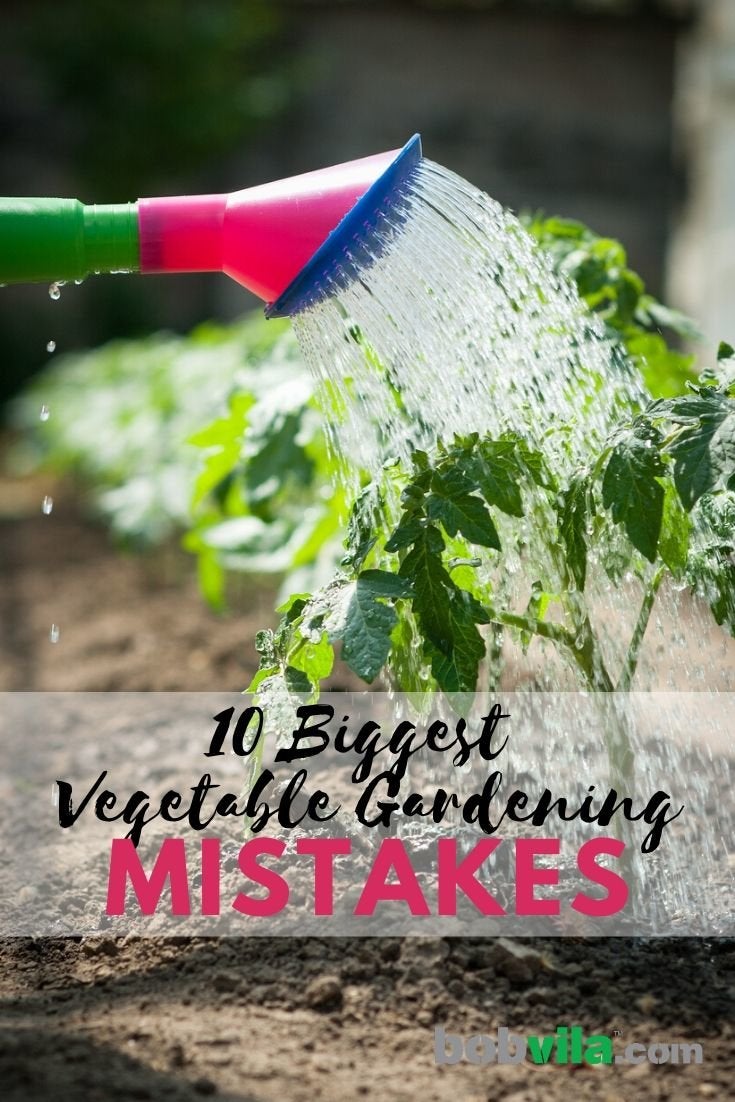

We may earn revenue from the products available on this page and participate in affiliate programs. Learn More ›
Home Advice You Can Trust
Tips, tricks & ideas for a better home and yard, delivered to your inbox daily.
Avoid Critical Gardening Errors

Starting an edible garden is a fun, rewarding process, but it can also be a huge undertaking. Some mistakes are easy to remedy, while others can turn into disasters as time goes on. Here are 10 serious mistakes you should avoid when starting your green-thumb journey.
Wasting Seeds

Don’t dump out a whole packet of seeds into your garden beds; it’s a huge waste. In most cases, fresh, properly stored vegetable seeds have a high germination rate, and there’s no need to toss them all into the ground. With the Square Foot Gardening method, precise spacing guidelines require only 2 to 3 seeds per hole.
Picking the Wrong Spot

Take your time to carefully consider potential spots for your brand new vegetable garden. The wrong choice can lead to headaches later on. Choose an area that receives plenty of sun—most vegetables need at least six hours of sunlight to thrive. Avoid places where water tends to pool, such as at the bottom of an incline or beneath gutters. Make sure your garden is accessible. You won’t find gardening very enjoyable if you have to trek to the depths of your backyard to get to your garden beds. Closer to home is always best; you’ll be more likely to check on your plants and keep up with the harvest.
Using Poor-Quality Soil

Those 99-cent bags of black earth are tempting, but don’t skimp on soil quality when starting a raised-bed garden. You’ll spend years building up soil health if you don’t start with the good stuff from the beginning. Spend a little bit more for ready-made, nutrient-filled mixes or make your own soil mix.
Over-Fertilizing

When it comes to fertilizer, more doesn’t necessarily mean better. Inexperienced gardeners tend to believe that by showering plants in concentrated fertilizer, they’ll be rewarded with jumbo tomatoes and giant heads of lettuce. Not true. Too much fertilizer can damage your soil and create harmful runoff that contaminates the surrounding environment. Formulas high in nitrogen create lush, leafy plants, but yield few fruits ready for picking.
Watering at the Wrong Time of Day

Don’t water your garden in the middle of the day. It’s a big no-no and is wasteful and dangerous for your precious plants. Water evaporates before it even touches the ground on a sweltering, sunny day, and droplets that make it onto your plants turn into magnifying glasses that strengthen the sun’s rays and leave plant leaves burned and crispy. Instead, water in the early morning or once the sun has begun to set in the evening.
Not Paying Attention to the Weather

A lot of gardeners—even expert ones!—have a habit of ignoring Mother Nature. Check the forecast often, and you’ll always be abreast of potentially crop-damaging weather changes. Is a storm coming? Make sure your tall plants are adequately secured. Is it going to rain for the next few days? Skip watering for now. If an unexpected frosty overnight is in the cards, checking your phone’s weather app allots you plenty of time to prepare extra protection for your plants (e.g., fleece covers or heavy blankets).
Ignoring Pollinators’ Needs

Edibles are great, but don’t skimp on plants that attract pollinators. Plant flowers and flowering herbs to entice pollinators to your garden. If you want your tomato and squash plants to bear fruit, you’ll need pollinators hanging around. Many flowering plants also attract predatory insects that feast on annoying garden pests.
Planting Invasive Species

Be wary before planting anything that claims to be quick-growing and easy to care for. Mint, for instance, is a super low-maintenance plant, but it spreads like wildfire and can easily overtake your garden beds. Purslane, an edible weed that’s become popular in recent years, has similar invasive qualities. Plant invasive edibles in containers and keep them out of your regular garden beds.
Forgetting About the Harvest

Here’s a secret: Planting is the easy part. Being prepared to harvest everything is one of the toughest aspects of gardening. If you wait too long to harvest certain vegetables, they may decline in quality, or plants may go to seed, turning any edible portions bitter and unpalatable. Before you start the season, know how to harvest everything in your yard, and come up with ideas for preserving and using what you grow.
Bringing Home Infested Plants

There’s no shame in buying starts at your local nursery, but always carefully inspect plants before heading to the checkout. Avoid buying plants that look sickly and never bring home a plant with signs of insect activity. All it takes is one infested transplant or potted plant to introduce stubborn pests to your garden. Bringing home pests also increases the chances of disease spread, which can further decimate your garden plants.

Meet the 2025 Tools of the Year
After months of scouring the market and putting products through their paces, we’ve named the best of the best in new tools. There’s something for everyone, from veteran pros to average Joes.
